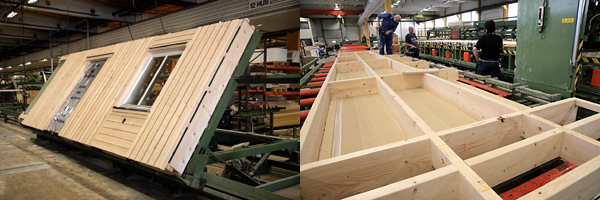Letters from Sweden - panel building in Sweden vs the USA
Ok, we've been beating around the bush, setting the stage, trying to understand the context in which this Swedish building method exists. If you've been following the series you get it, its dark, its cold, there is no building season for the better part of the year. They need a factory based system to have an industry there, and so they do. Lets look at it.
You've picked up by now that the Swedes are panelizing their houses. The walls are being assembled to the greatest extent possible in the factory. Windows and doors are installed, exterior siding, interior drywall. This means everything else within the wall is in there too - insulation, wiring, and plumbing where it exists. The studs are precut to the common height, and walls are laid out on great tables with the carpenters working at convenient work height. Sheathing, air barrier, and siding is applied and the panels flipped to gain access to the work that proceeds from the inside. Wiring conduit, plumbing, insulation and vapor barrier are all installed before wall board is applied. Some of the drywall is left off in strategic places to facilitate the installation of the panels on site, and this must be installed in the field. There is not genius in this, but never the less its near impossible in the US. Lets look at why.
 First off we have issues with construction inspection conventions in the US. Construction must be inspected before it is insulated, closed in, and the underlying work is obscured. Framing, plumbing, and electrical work are all inspected at this point. The modular industry has established a practice of third party certification to work around this, but this method would require a different routine as the proportion of site and factory work is not the same. Modular is more or less done with the set of the modules. Panelization requires the field inspector to pickup more of the inspection work again in the field, and I predict the blurring of lines of responsibility to elicit resistance. This is essentially an administrative obstacle, but real enough. This obstacle does not exist in Sweden.
Second are issues of products and standard construction practices. In Sweden products are designed to facilitate this panelization. In the US they are designed to be installed in the field. This purposeful design of construction products allows the Swedes to optimize their process. They are not fighting with the construction to break it into panels, like we would here. Next we'll look at some of these products in more detail.
Previously:
Letters from Sweden - Europe is different, Sweden is not, sort of..
Letters from Sweden - land of modern, land of prefab
Letters from Sweden - conversations with an expatriate builder
First off we have issues with construction inspection conventions in the US. Construction must be inspected before it is insulated, closed in, and the underlying work is obscured. Framing, plumbing, and electrical work are all inspected at this point. The modular industry has established a practice of third party certification to work around this, but this method would require a different routine as the proportion of site and factory work is not the same. Modular is more or less done with the set of the modules. Panelization requires the field inspector to pickup more of the inspection work again in the field, and I predict the blurring of lines of responsibility to elicit resistance. This is essentially an administrative obstacle, but real enough. This obstacle does not exist in Sweden.
Second are issues of products and standard construction practices. In Sweden products are designed to facilitate this panelization. In the US they are designed to be installed in the field. This purposeful design of construction products allows the Swedes to optimize their process. They are not fighting with the construction to break it into panels, like we would here. Next we'll look at some of these products in more detail.
Previously:
Letters from Sweden - Europe is different, Sweden is not, sort of..
Letters from Sweden - land of modern, land of prefab
Letters from Sweden - conversations with an expatriate builder
Technorati Tags: modern design, modern house, modular house, prefab house




One major issue is that in North America, most everything is designed to allow the unions and contractors to milk as much money out of the system as they can.
ReplyDeleteHence the repeated inspections, multiple coffee breaks and often times way to many contractors working at once and waiting for each other.
This Swedish method is great, but far to practical and efficient for North America.
The only problem with your argument is that the bulk of single family housing in the USA is not built by union labor. So if products and materials were introduced that sped up residential construction it likely would not change the amount of labor required for most union construction work. In fact the introduction of Swedish like building tech here in the states might allow more residential construction to happen in a factory, which could increase union labor participation in home building. I don't think you can blame this on the Unions - it does not add up.
ReplyDeleteI have not read this yet, but have been greatly following this conversation.
ReplyDeleteI look forward to it, and sharing my continued development with IBU modular homes.
sweden has the largest labor union forces in the world
ReplyDelete